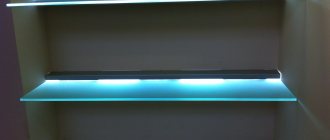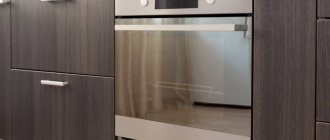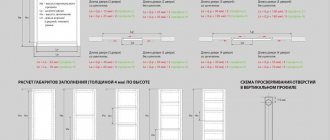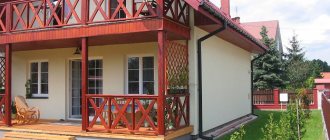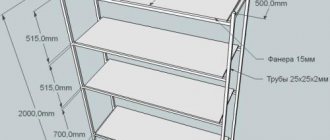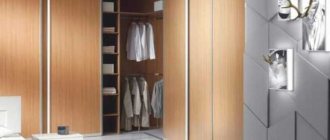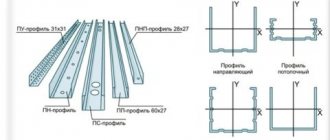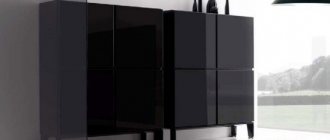Clothes dryer
In most apartments there is no way to dry washed clothes in the rooms, so you have to use the balcony. In summer, this method is generally advantageous, because under the sun's rays, clothes of any density dry almost instantly. In winter it is more difficult; a prerequisite for drying things is to have a glazed balcony, since otherwise they will only turn into ice.
But even in a glazed balcony, it is important to organize the clothes dryer in such a way that there is free access to the window, because it has to be opened regularly to ventilate the room. Otherwise, mold and dampness are inevitable.
Convenient clothes dryer for the balcony
In the cold season, you will still have to dry your clothes in the apartment, no matter how good the dryer on the balcony is. An excellent option to avoid this are batteries. In some apartments they are specially placed on the balcony in order to facilitate the drying process.
When buying an apartment, the balcony is not given the same attention as all other rooms. In fact, this room is irreplaceable, so if you see mold, unpleasant odor and dampness on the walls, immediately think about where the laundry will dry. If there are no options for organizing a dryer in the room, this will create many problems.
Outdoor option
Advice You should never delay repairing your balcony if you use this room for drying clothes.
When the first signs of dampness, mold and other unpleasant phenomena are detected, they must be eliminated immediately. Otherwise, after some time it will be impossible to use the dryer on the balcony.
Types of clothes dryers for the balcony
Wall-mounted clothes dryer for the balcony
There are three main types of clothes dryers on balconies. They can be:
- 1External;
- 2 Internal with ceiling mounting;
- 3 Internal with wall and floor placement.
An external drying system is installed with your own hands outside the balcony if it is not large in size. To do this, metal profiles and steel corners with holes are installed on both sides of the window opening.
A clothesline should be stretched between the profiles for drying on the balcony. The presented design is very convenient for a number of reasons: this type of dryer is the most suitable option for summer drying - the sun will quickly warm up the laundry. An external dryer on the balcony with things hung on it will not clutter up the interior space. But they also have a significant drawback - dust particles will be blown along with the wind, and if it rains, they will have to be washed.
Floor and wall dryers
Floor-mounted clothes dryer on the balcony
A floor-mounted device for drying clothes on the balcony does not require a permanent fixture. Such a product, if necessary, unfolds and folds up when drying is complete. This frees up about 1.5 square meters. m. balcony area. When folded, such a product reaches a width of no more than 5 cm, and therefore it can be easily placed behind a cabinet or rack.
A DIY floor dryer can be equipped with additional wings, between which you can additionally stretch a certain number of strings. Thus, the area for hanging things will increase significantly. This floor design is very convenient - if necessary, you can expand either one or two wings at once. In addition, this device can be easily transported to another room.
Wall-mounted dryers are presented in two main modifications and can be:
- 1Capital;
- 2Foldable.
The permanent type device can be attached with your own hands on parallel opposite narrow walls. This is done in order to stretch the ropes along a wide wall. Folding models can be presented as:
- Ladder dryers;
- Dryers with removable ropes;
- Dryers with rollers for ropes.
The wall-mounted dryer for balconies is quickly brought into working condition and does not take up extra space on the balcony. However, such a device always visually clutters the loggia with an excessive amount of details.
Advice! When choosing a wall or ceiling clothes hanger on the balcony, special attention is paid to the material of the walls. In some cases (if the wall is concrete), strong dowels and drills will be needed to install the structure.
Ceiling drying racks
Installation of a wall-mounted clothes dryer
Such systems (especially hanging vines) are generally considered the most acceptable option. Liana is not capable of occupying a certain area of walls or floors when installed. In addition, you can hang such a device with your own hands without outside help. If few things dry on a dryer of this type (except for towels and bedding), then they will not interfere with free movement around the loggia. The presented design is practical and does not attract attention. A ceiling-type balcony dryer can be:
- Capital type;
- Retractable;
- Liana.
The “liana” type laundry rack for the balcony is presented in the form of a massive structure consisting of two fastening blocks. The design of the vine is different in that each bar of such drying can be lowered to the desired height, regardless of the location of other ropes. When choosing such a rope for a balcony, special attention is paid to its practicality.
Pros and cons of dryers
A dryer on the balcony is more of a necessary measure, rather than a whim. If there are no other options, then you have to occupy this room. However, this process does have positive aspects; it is not without reason that it has long been practiced in many developed countries:
- space in the apartment is saved;
- the laundry is ventilated, a pleasant smell of freshness appears;
- It’s easy to block children’s access to wet things - you can simply close the door;
- hiding laundry is also easy - you can simply curtain the window to the balcony.
Saves space in the apartment
These advantages are especially noticeable in those apartments whose balcony windows do not face the road, but the forest or other nature. No rinse aid will give things as much freshness and aroma as such a natural scent.
Advice If the balcony windows face the highway and other dusty places, it is best to dry clothes at night and early in the morning.
A clothes dryer on the balcony also has disadvantages. However, they are not so catastrophic as to abandon this process; it is important to simply know all the nuances and learn to adapt to them. Among the disadvantages of a balcony clothes dryer are the following factors:
Dependence on weather. If it rains and the window on the balcony is open or there is no window at all in the summer, most likely the washing will have to be repeated again. To avoid such situations, it is better to dry things when someone is at home and check the weather forecast in advance.
Linen must be hung very carefully
The smell of smoke. Some people use the balcony as a smoking area, so if neighbors below smoke and the balcony windows are open, the smell of smoke will certainly be absorbed into their clothes. And if they smoke from above, then ash may also fly into the window. To prevent such situations, it is better to use the dryer with the windows closed, and ventilate the room before and after.
Danger. No matter how strange it may sound, we still hear about cases where people fell out of a balcony window while hanging laundry, especially if they did it behind the balcony. In this regard, it is important to take safety precautions when also caring for small children.
Portable option
Note: In some countries, drying things outside the balcony (on the street side) is strictly prohibited by law. The authorities believe that this spoils the overall appearance of the city and creates an unfavorable impression among tourists.
Aesthetics
Many people, especially women, worry that a dryer on the balcony can ruin their reputation in the eyes of guests and create a bad impression of the comfort in the apartment. If this moment worries you too, you can apply a few simple rules and tips. They will help organize the drying of things in such a way as not to spoil the overall appearance of the apartment.
Will not spoil the appearance of the balcony
As already mentioned, the practice of drying things on the street side of the balcony has long been outdated, and besides, such behavior is considered a sign of bad taste. Few people want their clothes, and especially their underwear, to be examined by strangers, while some, without hesitation, hang them out for everyone to see. Even if it is not possible to dry everything at once, you need to adapt to your circumstances and wash less, but more often.
In order to hide wet things from the eyes of guests, you need to take care of the presence of a curtain that would cover the window between the room and the balcony . It is desirable that it be dense and not see through. Some housewives find an original solution to this problem - they place a large climbing flower on the windowsill, which completely covers the entire glass, so that no one will guess that it is not just a houseplant, but also an important part of the interior.
Saving space on the balcony
It happens that it is not possible to close the curtain: if guests come during the day, then there must be daylight in the room. In this case, a simple rule that should always be followed when hanging clothes will be useful: intimate items, underwear should be located in the center, and everything else on the sides. Then sweaters, T-shirts and other large clothing will be a kind of barrier protecting intimate clothing from prying eyes.
Where is the best place to dry clothes?
Owners of city apartments do not have many places to dry clothes. Those who are lucky enough to have a large glazed balcony or loggia can install a folding dryer there or, in the old fashioned way, string ropes under the ceiling. This would, perhaps, be the best way out of the situation, but there is not always free space on the balcony.
Typically, a balcony is used to store various necessary and not so necessary things, or performs some useful function - a pantry, smoking room or terrace, where you can have a cup of coffee in the morning while admiring the city landscape. In general, a balcony is rarely an extra, unnecessary room that can be assigned the function of drying clothes without loss.
Another solution to the problem could be to install a folding dryer in any free corner of the apartment. Usually this corner becomes the corridor. If you don't do laundry every day, there's no harm in installing a dryer like this for one or two nights a week. But if you have small children in your family, then washing and drying clothes becomes a permanent process that continues for many months. In this case, a folding dryer loaded with clothes will become an invariable attribute of the apartment.
It is worth noting that such a dryer takes up a lot of space and, moreover, is an excellent bait for kids who strive to tip this entire structure over their heads.
An excellent way out is a clothes dryer designed specifically for the bathroom . The bathroom is just perfect for drying. This is usually the cleanest room in the house, away from small children and pets. Special bathtub dryers are great for small apartments where every centimeter of free space counts. The variety of designs offered allows you to install the dryer almost anywhere in the bathroom.
Related article: Toilet care. How to properly wash and clean a toilet at home?
Clotheslines
The easiest way to organize a dryer on the balcony is to string ropes. At first glance, it seems that there is nothing complicated about this. But those who have ever had to waste time re-washing clothes because they were found on the floor with broken ropes know that this is not so.
The easiest way
To begin with, it is important to choose the right material - it should be light, but at the same time durable so that it does not wear out quickly. Also, it should not stretch like an elastic band and get dirty, because if the rope turns black, it is unlikely that any housewife will want to hang clean laundry on it. The most suitable materials, which are easy to find, are:
- metal cable wrapped in PVC;
- jute;
- polypropylene.
Metal cable
There are also standard materials that are inexpensive, but can serve you well for a while. However, their endurance is not so long, over time they begin to sag lower and lower, and they also quickly get dirty, so after that you immediately have to look for a replacement. These include :
- standard twisted rope, which is in greatest demand among residents of our country;
- plastic, which attracts attention with the variety of available colors.
To secure the rope to the wall, you have to make special structures with your own hands, since it is usually sold not as a set, but separately. To do this, you will need two slats, their length depends on how many rows will be located. They are attached opposite each other; for reliability it is better to use strong nails or special screw-in hooks.
Good choice of clothes dryer
Advice The easiest way is to first firmly tie the edge of the rope to the outermost nail, then stretch it in different directions, wrapping it around each nail on the slats. A strong knot is made on the last nail, as on the first.
Peculiarities
So, when choosing a clothes dryer, you should pay attention to the following features:
- Design. The choice of dryer design depends on where in the bathroom it will be located, as well as how often you will use it.
- Manufacturer. If possible, try to pay attention to products from well-known brands. For example, dryers from Leifheit and Gimi have proven themselves well.
- Quality. Before purchasing, try to test the structure for strength and pay attention to the material from which it is made. The material must be moisture resistant.
- The weight of the laundry is usually indicated on the packaging or on the instructions for the dryer. You should not neglect these instructions, because if you overload the dryer, it will not last you even a month.
Related article: Ultrasonic bath
Lianas
Linen vines look stylish and do not spoil the overall appearance of the balcony. In addition, in terms of strength and service life, such a dryer is several times better than simple ropes attached to slats. It belongs to the category of ceiling devices for drying things.
Lianas for linen
The vine is a frame equipped with cords and attached to a mechanism on rollers. One of the advantages of this model is that the length of each rope can be easily adjusted. Thanks to a special clamp, the rods can be easily fixed at the desired level.
Many note another advantage of the vine - it can be folded and in this position it takes up absolutely no space and does not attract attention to itself . The latest models are made so thinly that looking at them in assembled form, it is generally difficult to understand what it is.
long vine
Installation of vines
It begins with preparing the fastening; it can be wooden beams or any other made of durable material. After this, you need to mark the place using a tape measure and a pencil. To install panels with rollers, you will need to drill into the previously installed fastening and drive a plug into it, and screw the panel on top.
After this, 1.5 m is measured from the floor and a bracket is attached, the ropes are alternately pulled through the panels with rollers. In this case, the short one is directed towards the fastening, and the long one clings to the roller opposite itself and descends along the fixed bracket. As a result, all ropes become the same length, stretched evenly.
Ceiling dryer
Ceiling dryers are more practical to use than wall-mounted ones, because they take up minimal space, while being very practical in functionality. Even ordinary clotheslines attached to slats also fall into this category. This demand is absolutely justified, because ceiling systems have a number of advantages:
- both the floor and walls of the balcony remain free, so you can move freely and arrange the necessary furniture;
- do not attract attention when there is nothing on them;
- It doesn’t require a lot of expense, and some of them can be done by purchasing only the necessary materials.
Most practical to use
One of the popular models of ceiling dryers are retractable systems called “accordion dryers”. The principle of operation of the mechanism is that the model is attached to the ceiling, and in order to hang laundry on it, it must first be lowered to the desired level.
There are different versions of the release system for pull-out dryers, the most popular of which is a mechanism that operates by pulling a string. It is enough to pull it down, and the structure immediately lowers; immediately after it is released, it stops. The structures themselves can be of completely different sizes and contain any number of ropes.
Often, in retractable ceiling dryers, thin pipes made of plastic or other material are available instead of ropes.
The disadvantage is the fragility
The only drawback of this ceiling model is its fragility . Most pull-out dryers are designed to weigh no more than 5 kg, but even then they often fail prematurely. Therefore, such ceiling models are suitable for small families who dry things in a small volume.
Advice Some housewives successfully combine several types of ceiling dryers. For example, you can use both a retractable dryer and Liana, which inherently also has a retractable mechanism. But you can combine them only if you have a large balcony, which is used only for drying clothes.
Varieties of design and installation methods
Several rows of ropes stretched over the bathtub, intended for drying clothes, are by no means a new phenomenon. Today this design has been somewhat modernized, making it much more convenient to use.
Ceiling-mounted clothes dryers consist of two brackets that are attached to the ceiling. Thin metal rods are suspended from brackets. Using a mechanism consisting of rollers and ropes, the rods (one at a time or all at once) can be lowered to hang laundry. This dryer is very easy to install: using dowels, the brackets are attached to the ceiling on both sides, and part of the structure is fixed to the wall in order to fix the ropes in a certain position.
A more modern modification of the ceiling dryer can be considered a wall dryer . In this case, the brackets are attached not to the ceiling, but to one or two walls of the bathroom. Ropes are stretched between the brackets on which the laundry will be hung. The length of the ropes is adjusted by a roller mechanism. The ceiling dryer can be stationary or folding, which can be removed if necessary.
The folding dryer is attached to only one wall, which does not allow placing a large amount of laundry on it. Outwardly, it resembles an accordion, which when folded takes up virtually no space on the wall. This dryer can also be used as a towel holder.
The floor-mounted clothes dryer is a folding structure similar to an ironing board. It takes up quite a lot of space and is therefore only suitable for spacious bathrooms. The strength of such a dryer depends on the manufacturer, so it is better to choose more expensive models. A significant advantage of a folding drying rack is that it is very easy to fold and hide, for example, behind a closet or behind a door.
The battery dryer is a compact design that is more suitable for drying towels and underwear than for clothes or sheets. It looks the same as a ceiling dryer, only it is attached to the radiator. However, not every bathroom has radiators, so some people attach such a dryer directly to the bathtub. This is not entirely convenient, as it makes it difficult to approach the bathtub, and it is not always possible to protect drying clothes from splashes of water and household chemicals.
Related article: Features of installing thresholds for laminate and tiles
Perhaps the most impractical option is a bathtub dryer . It is a triangular frame with stretched ropes or slats, which is placed on the sides of the bathtub. This device is very unstable and, besides, you can’t hang a lot of laundry on such a dryer, otherwise this whole structure could end up right in the bathtub. However, if you use it only occasionally and mainly for drying small items, then such a dryer can be very convenient, since it does not require much storage space, and installing it is not difficult even for a child.
Floor
A floor-mounted clothes dryer can be used not only for balconies, but also in any room, however, many simply do not have the space to place it in their room. These models are used mainly in cases where, for some reason, it is not possible to attach ceiling ones. In some apartments, the walls and ceilings on the balconies are so unreliable that it is not worth painting, so you have to do without using them.
Used not only on balconies
Floor dryers have their advantages, the main ones include:
1 Mobility . If you suddenly need to move the dryer from one place to another, or even temporarily to another room, this can be done without any problems. They are usually not heavy and can also be folded to make them easier to lift. 2 Variety of sizes. Floor dryers come in completely different sizes, so there is a suitable option for any family size. Also, such models are often used as an addition to ceiling ones; some attach a retractable model to the ceiling, and place a floor model underneath.
For different types of things
3 Option not to use . If you have attached a ceiling dryer, it is unlikely that you can easily remove it the first time you need it. However, floor dryers are more practical - they can be easily folded and put away, especially since when folded they usually take up little space. 4 Easy to attach . Unlike other models, these do not need to be screwed or otherwise secured using tools. All you need to do is simply press on the mechanism, and it will immediately open.
Types of floor
The most popular is the classic type, the mechanism of which resembles the principle of folding out an ironing board. The support consists of pipes crossed between each other, the shape of which resembles the letter “X”. Clothes are hung on pipes, of which there can be any number.
Stylish dryer option
When choosing a classic floor dryer, special attention should be paid to the strength of the tubes. Some cheap models are not designed to withstand a weight of more than 5 kg and it is better not to buy such ones, because even if someone accidentally leans on it, it will immediately break. It’s worth thinking about whether it’s really necessary to save money when purchasing, and then go to the store again a month later.
For families with small children
In families where there are small children, and, therefore, a large amount of clothes are washed, multi-tiered floor dryers will be practical. They are structures, often from floor to ceiling, on which pipes are placed. Outwardly, they look as if several classic models were stacked on top of each other.
Among the assortment of floor dryers, there are often Chinese models known for their fragility. To avoid buying them, you must carefully study the manufacturer’s instructions yourself, without trusting sellers.
Hanger
Hangers for drying clothes on the balcony are the only way to dry and store clothes in a natural position. This is especially practical for drying men's suits and other large items that should not be folded when wet. Everyone has at least once had to spend time smoothing out wrinkles that appeared as a result of drying things in the wrong way.
Convenient to dry men's suits
Drying hangers can be used as an auxiliary structure, that is, you can use a floor dryer and one at the same time, or combine it with any other models. Another advantage of this method of drying things is that you can use the means available in the house. The easiest way to build a dryer with hangers is this way :
- We are looking for a pipe of the required length; it must reach from one wall to another, and there must be room for fastening. An excellent option would be a hanger holder from a wardrobe. You can use the one that is no longer used in the closet, or you can purchase it separately; usually the holders are sold as separate spare parts in many furniture stores.
- We attach the pipe or holder to the walls. Some of them are attached directly to the ceiling; you just need to tighten the holders with screws. Using such designs, it is easier to choose the length, because it does not have to be from wall to wall, it can occupy half or any desired part of the ceiling.
- We select the required number of hangers and dry the clothes. Some people use the same ones on which clothes hung in the closet for this, but this is not advisable. It is better to have hangers separately for storing clothes in the closet and separately for drying.
It is possible to attach a hanger - this is sometimes not enough
Tip In furniture stores, in departments with ready-made clothes dryers, they sell special hangers made of moisture-resistant material. Their use is convenient and practical, because they can last a long time.
This will be interesting for you:
240+ Photos of finishing options for the Balcony inside: Beautiful interior with your own hands
Wall-mounted fan dryer - how to make it yourself
- The next type of dryer is also quite popular. It’s not difficult to make, but the appearance is original and can also transform the balcony.
To make such a device, you will need:
- stair balusters,
- board,
- nuts and bolts,
- steel corner.
Related article: Features of installing fabric stretch ceilings with your own hands
As you can see, the list is small, which is what makes this design attractive. Balusters for stairs fit perfectly into the dryer as holders for clothes. They can be purchased at any construction market at an affordable price. The middle part of the baluster, where the laundry will hang, should not be embossed. The edge where the round section becomes square needs to be cut off, and the second edge simply shortened.
Wall-mounted clothes dryer on the balcony - a convenient and practical solution
Next you need to proceed like this:
- The second edge, which has a square cross-section, is the hinge. You should step back 2 cm from the edge and drill a hole one centimeter in diameter for the bolt in the center. This structure will be attached between two corners.
- For a concrete wall, the corners are attached directly to the wall, but if you are dealing with drywall, the holders are installed on a kind of backing. Its role will be played by a base board similar to the one that appeared in the previous instructions.
- The holders should not dangle during assembly, but they must be slightly rotated; a washer is placed between each baluster.
- And the final finishing of the holders concludes the whole work. The easiest way is to varnish them, after treating the wood with sandpaper. But you can, of course, paint the entire structure in your preferred color.
As you can see, everything is simple: the dryer is convenient, unusual in shape, and most importantly, not bulky. If the balcony is small, such a product is quite appropriate.
Wall-mounted dryers have many advantages, and the main thing is that the choice of models is wide. Compact, unusual in design, easy to use, lightweight - they become an integral part of the balcony, and at the same time do not steal space.
Good luck with your choice!
Do-it-yourself portable clothes dryer (video)
The best posts
- How to make ventilation in a metal garage
- Decorative plasterboard - for effective decoration of premises
- Do-it-yourself piglets from plastic bottles for the garden
- Children's wallpaper for a girl: photo, for walls in a room, children's wallpaper for a teenager 12 years old, for a boy and girl 14 and 10 years old, design in the bedroom, video
- How to join drywall in corners and the process of building a decorative niche
- How to glue meter-long non-woven wallpaper on walls and ceilings
- To what temperature can you keep flowers on the balcony?
- Balcony finishing with sandwich panels
Wall dryer
Wall-mounted dryers can be used in different cases: if it is not possible to use a ceiling dryer, if the ceiling on the balcony is too high, so it is not easy to reach the rope, and for other reasons. This category consists of various models that differ in design, mounting method and other parameters.
Inertial
When folded, these dryers are very compact, so there are no problems with storing them. Inertial models consist of two parts :
- Frame. Equipped with a drum with springs that tensions the cord and, if necessary, hides it inside. Thanks to this, good tension is ensured, so that the cord does not sag, and even over time, the clothes still dry at the desired level, and do not interfere with walking.
- Fastening. It can use either hooks attached on the other side or a bar. The mount is permanently present on the wall, and the body is put on it when necessary to dry clothes.
The inertial option is good for a balcony with a high ceiling
The cost of inertial clothes dryers varies, but cheaper models are less practical - over time, the cords on them still begin to sag, so that the tension becomes not the same as it was originally. On more expensive models, this problem does not arise, because the housing drum is equipped with a tension function, so as soon as the cords begin to sag, you can immediately use it.
Console
These wall-mounted dryers are even more compact than inertial dryers. If you need that immediately after drying there is no trace of ropes and cords left, this option will be suitable for you. When it is closed, you can see a small plank on the wall, no more than 10 cm wide, and its length can be different, depending on the model you choose.
They are even more compact than inertial ones
When a cantilever wall dryer is unfolded, tubes arranged in rows extend out. You can either simply throw clothes on them, or fasten them with clothespins. Like inertial models, such models are not designed for drying large amounts of laundry; it is usually recommended to weigh no more than 5 kg.
Sliding dryer
If you need a wall-mounted clothes dryer on the balcony, but the permissible weight does not suit you, sliding dryers are an excellent option in this case. Standard models can withstand a weight of no more than 10 kg, but if necessary, even more durable models can be found.
The sliding dryer is a structure made of metal pipes, which explains its strength. When the system is folded, it takes up very little space, since the pipes themselves are thin. In order to use the dryer, you need to open it - just grab the outer pipe and pull it towards you.
In wooden version
As a result, the design, which when folded seemed like one continuous metal pipe, turns into a multi-tier drying rack on which you can place many things. Considering that a sliding dryer is designed to carry more weight than inertial and cantilever dryers, it is necessary to pay due attention to fastening. For this, both dowels and screws can be used, but the main thing is to ensure powerful fixation.
How to choose a good dryer for the balcony
If building such a useful thing as a dryer is not part of your plans, you can buy the structure. But the choice is wide, and how do you know what is convenient for you?
The following tips will guide you:
- Folding drying rack . Usually these are inertial models in the form of a drum, on which ropes are wound. Some models may only have one rope, while others contain up to 10 ropes. This device is used like this: the ropes are unwound and fixed on hooks on the opposite wall. When the laundry is dry, the ropes are removed from the hooks and they themselves wind around the drum. The “disadvantage” of this dryer is that it cannot handle a lot of heavy laundry.
- Telescopic dryer . The principle of its operation is that the tubes simply slide into each other. And when folded, it simply looks like a towel holder. Metal tubes and sometimes strings are used for laundry. This increases the strength of the structure, as well as its load capacity.
The disadvantage of a rope clothes dryer is the frequent sagging of the ropes and the fixed height
- Console dryers or accordion . They look like sliding mounts with metal tubes (5-7). The tubes are round, so there are no unwanted creases in the laundry. This dryer can withstand a large weight of laundry, about 10 kg.
- Rope dryer . A cheap product, but the rope, no matter how you look at it, will sag over time. But the structure quickly and easily folds to a minimum size. And for very small or cluttered balconies this is the only acceptable option.
These are just the most common types of wall dryers. Of course, you should also pay attention to the material from which the structure is made. For example, plastic dryers. They are inexpensive, their color palette is wide, they look light and bright, without weighing down the interior of the balcony. Quite durable.
Chrome plated steel dryers are designed to last for many years. They do not rust and can withstand a lot of laundry. But on a small balcony they can look like a weighing element. More expensive in price.
Console clothes dryer significantly saves balcony space
Related article: Do-it-yourself homemade auger snow blower
When folded, the telescopic clothes dryer does not have large dimensions
The “lift” dryer, located right under the ceiling, is the most convenient option for a loggia or balcony
Aluminum polished dryers are a compromise option. They will decorate the balcony, light, durable, beautiful.
The type of dryer with textile elements is also popular now. If the fiber on them is synthetic, the structure will last a long time, since synthetics are not as afraid of fungi and mold as natural material. Typically these devices have a tension regulator.
Wall dryer (video)
Electric
A couple of decades ago, no one had heard of electric dryers, but today you can buy them in many stores. These designs consist of a bar with rays emanating from its center. The beams usually have different sizes, large ones are used for drying larger items, and small ones are used for smaller ones.
At the bottom of the electric dryer there is a device that supplies hot air. The cost of such models is higher than that of others; the main factor influencing it is the material. Typically electric dryers are:
- aluminum is the cheapest option, but it does not last long, since this substance quickly oxidizes, and rusty stains remain on clothes;
- made of stainless steel - a more expensive option, but at the same time more durable;
- steel ones are the most durable and reliable models, the only drawback of which is their high cost.
For those who are always in a hurry
Advice The most popular electric dryers are made of stainless steel, because they are more expensive than aluminum ones and have good strength. However, when purchasing, you must carefully study the instructions, since unscrupulous manufacturers may add an admixture of aluminum, so that over time the structure will begin to oxidize and become unusable.
General installation rules
- Think about what your weight limit is. Remember that if you always load the structure to the maximum, weighing the maximum permissible weight, then its service life will be significantly reduced. It is better to take a model with a weight reserve; if you usually dry several kilograms of laundry, then a dryer with a permissible weight of five kilograms will be enough.
- Carefully consider the location of the dryer, as some models are mobile and easy to move, while others are simply not possible. Draw a plan on the wall or ceiling and think through all the little things: try opening a window to see if it will interfere with the structure and whether there will still be a passage.
Installation is quite simple
- If you are planning to repair your balcony soon, then you should wait to install a clothes dryer, since some structures cannot be reattached after removal. If the apartment, including the balcony, is designed in a certain style, then you will have to pay attention to the design of the dryer so that it does not spoil the overall appearance.
- If you have children, be sure to consider dryer safety. For example, if the wall model is placed too low, the child may be able to reach it. As a result, it will break, but what is even more dangerous, he may get injured.
DIY dryer
If you don’t see the point in spending money on purchasing something that you can do yourself, try making a dryer for the balcony with your own hands. At the same time, if you have never dealt with such work, it is better not to take risks. The easiest way to make a design yourself consists of several stages:
- We attach two planks of wood or metal on walls opposite each other.
- We attach ring-screws to them; how many ropes are needed, so many pairs of screws are needed.
- We make small holes for the screws, the diameter of which should be slightly smaller than the holes themselves.
- We screw in the screws, it is important to ensure that they are fastened firmly.
- If there are empty gaps in the places where the screws are screwed in, they must be sealed with ordinary putty or other means to impart strength to the structure.
- We stretch the rope, threading it through the prepared ring-screws, and secure it with strong knots.
Easy to do it yourself
It’s better not to skimp on a skein of rope; it should be strong and durable enough so that you don’t have to buy a new one in the near future. When tightening, you need to take into account the “golden mean” - it should not sag, but too much tension will lead to it simply breaking.
Tip When making a dryer with your own hands, you can take into account all the nuances of your own balcony, free space, quality of walls and ceiling and other features. If you don’t have time to bother, then you can find ready-made models from ready-made options by considering different options.
Thus, using clothes dryers on the balcony has certain disadvantages : dependence on the weather, the possibility of dust contamination, and the risk of absorbing the smell of cigarette smoke. At the same time, the advantages of the designs outshine all the disadvantages: you can choose a mobile model with any convenient mounting - on the wall, ceiling, floor. At the same time, you can decide for yourself how much and what space the dryer will take up, and also choose any design and even color.
Wall-mounted clothes dryer - how to make it yourself
This design is an excellent opportunity to show your creative powers, because this device is not difficult to make, but originality and love for creating things with your own hands will come in handy.
You can make a small dryer, which will serve as a decorative element on the balcony during non-working hours.
The following materials and tools will be needed:
- wooden rods,
- nails or screws,
- wooden blocks,
- dye,
- furniture hinge,
- locking lock,
- base board,
- folding mechanism,
- furniture buttons.
First of all, you need to assemble the mobile component of the dryer. To do this, you need to measure and cut four pieces of beams to get a frame. After this, you need to cut four identical pieces of wooden rods. Using a drill, carefully make holes in the beams where the rods will be inserted.
A rope clothes dryer on a roller mechanism can be moved outside the perimeter of the balcony
The rods need to be inserted tightly enough so that the grille comes out strong - things can still hang there, even heavy ones. To make the structure more convenient to assemble, the rods can be trimmed and narrowed at the ends.
The process then develops as follows:
- You need to make sure that the dryer is level, the crossbars are parallel, and the rods are firmly fixed. If you leave some unevenness, the balcony will clearly not benefit from the outside. If you are convinced that everything is fine, the upper and lower beams are attached with screws or nails to the structure.
- The base board, which will be on the wall, is adjusted in size to the grid you have already made. The width will be equal to the lattice, and the length of the board should be 10 centimeters longer than the lattice. These parts are connected with a furniture hinge.
Related article: How to grow tomatoes on the balcony
It’s not difficult to make a folding wooden clothes dryer with your own hands
Using ropes and rings screwed into the wall, you can make a simple drying rack
- Now you can start painting the future dryer. The color is chosen that will only decorate the balcony. For example, if your balcony is pistachio in color, the dryer can be a tone lighter or a tone darker. In general, any color that will please the owner’s eye will do.
- Once the paint has dried, it is time to complete the dryer with all the missing functional parts. A locking lock is attached to the top of the dryer.
- The folding mechanism should be screwed on the side. The size depends on how far you want your wall-mounted clothes dryer to fold out. Some people need it to not take up more than a fifth of the balcony, while others are ready to sacrifice more space.
- Now at the bottom of the base board you need to mark three points, between which there will be an equal distance, drill small holes at these points and secure furniture buttons in them. Furniture buttons are handles that, if desired, can replace simple hooks.
The design is ready! The end result will be a nice compact structure made from a board, for example, peach-colored and a snow-white lattice with buttons underneath. When necessary, the grill moves forward and clothes are dried on it. When not needed, they lean against the base board and look like wall decoration.
Furniture buttons or hooks are convenient for hanging things on a hanger that, for example, need to be ventilated. This design will certainly not only decorate the balcony, but will also save space on it.
